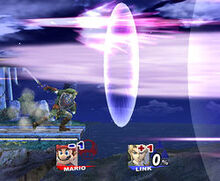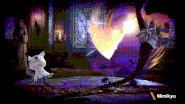A KO, short for Knock-Out or Knock-Off, is the term used to describe the situation where a player is knocked back beyond the stage's blast lines by the opponent's actions.

Standard KO
The KO'd player is sent to a revival platform to re-enter the match. The following may then happen depending on the type of match:
- In a Time match, the KO'd player will lose a point, while the player who made the KO gains a point.
- In a Stock match, the KO'd player loses a stock. If a player loses all of their stocks they will receive the following:
- Single-player: A continuation or a Game Over (if the player doesn't have enough coins in Melee and Brawl, or chooses to quit).
- Multiplayer: Removal from the rest of the match.
- In a Coin match, the KO'd player loses half their coins, rounded down. SSBB prevents a player from losing more than 100 coins at once. The lost coinage will fly into play if the KO was made off the side.
- In the Subspace Emissary, the next character in the lineup is loaded and teleported into play without a revival platform. One stock is also lost.
- Characters can also be KO'd in the Subspace Emissary if they are crushed by moving walls, ceilings, or floors.
If a player has no stocks remaining, then they do not reappear. They are then either removed from play (multiplayer matches) or receive a Game Over (single player modes).
KO Property
In Super Smash Bros. and Super Smash Bros. Melee, each character has a "KO property" which starts out empty. When a character is hit by an attack (be it a physical attack, a projectile, an item, etc.), their KO property is set to match whoever made the hit. The KO property is reset once a character lands on the ground and is no longer moving as a result of the attack's knockback. When the character is KO'd, the KO goes to whoever matches the KO property. If the property is null, the KO counts as a self-destruct. In simple terms, it goes to whoever made the last hit. Stage elements in SSB will reset the KO property to null with the exception of the acid on Planet Zebes, so for example, if a character is sent flying by an opponent's attack but is then hit by an Arwing's laser and KO'd, nobody receives the kill.
However, for whatever reason, this format was heavily altered for Super Smash Bros. Brawl. In SSBB, a character's KO property is never reset during a stock. If a character is hit at any time during a stock, it becomes impossible to self-destruct; a KO will be given to whoever made the last hit. So if a character is hit by an attack and jumps off the edge, it will count as a KO, not an SD. It gives other characters free KOs when the target character dies on his/her own. In Super Smash Bros. Ultimate, Sometimes all fighters get a Star KO or Screen KO.
One-hit KO
A one-Hit KO (or abbv. OHKO) is an attack with such high base knockback that it KOs at 0%. However, almost all of the so-called OHKOs are highly conditional; they all share the following restrictions:
- The opponent does not tech, DI, momentum cancel, and/or crouch cancel.
- There is no wall (or ceiling) to absorb the knockback.
- Knockback may be insufficient to KO at 0% on very large stages (e.g. Hyrule Temple, New Pork City, 75m.).
- Knockback may be insufficient to KO at 0% if the attack had been landed previously (due to Stale-Move Negation).
- Knockback may be insufficient to KO heavy characters at 0%.
- The opponent is not giant and/or metal.
- The damage ratio is on 1.0 and no handicaps.
The typical rule of One-Hit KO's is being able to KO the majority of characters from the center of Final Destination at 0%.
Examples
- Mr. Game and Watch's Judgement Hammer with a number 9.
- Roy, Ike, or Marth (SSBB only) countering a damaging enough hitbox (much more likely to be an OHKO with Roy).
- Roy's fully charged Flare Blade.(Depends on Stage and Character.)
- Ike's stage 8 Eruption
- End of Day, depending on stage size (more likely to be OHKO on smaller stage if Olimar perfectly performed it on opponent).
- Puff Up, depending on stage size (more likely to be OHKO on smaller stage if the opponent is close to its body).
- Aura Storm, if Lucario has taken more than 200% damage.
- Marth (SSBB)'s Critical Hit, unless a move with Super Armor is used (i.e. Ike's Aether)
- Mr. Game and Watch's Oil Panic if it is filled with strong projectiles and/or Zero Suit Samus' Down Smash.
- Luigi's Negative Zone, if combined with Fire Jump Punch (or Down Taunt on lighter characters).
- Getting hit by a walking Bob-omb after being reflected by Fox's reflector in SSB.
- A Side Smash with the Home-Run Bat.
- Touching Moltres in both Melee and Brawl unless using Momentum Cancelling.
- Suicune's Aurora Beam.
- Deoxys's Hyper Beam (after the blast gets slightly narrower).
- Bonsly's Body Slam on light characters.
- The Dragoon.
- Wario Man's fully-charged Wario Waft.
- Little Mac's KO Uppercut.
- If a Hothead is hit by a fire-based attack that does over 30%, such as Ike's stage 7, 8, and fully charged Eruption while it is uncharged, it will OHKO when Smash Thrown. Any sparks it gives off while traversing the stage at this strength will also OHKO.
- If a Soccer Ball is launched at enough speed, such being hit by an extremely powerful attack, like the Home-Run Bat, Marth's Critical Hit, or being launched after sustaining enough damage, it will OHKO anyone it slams into.
- Corneria's cannon laser shots.
- Touching the hull of the Pirate Ship.
- The first spike on Rumble Falls (can easily be teched).
- Getting crushed in the Subspace Emissary.
- Tabuu's Off Waves (on Normal or higher difficulties in SSE) (Hard to Intense in Boss Battle Mode).
- Tabuu's Golden Bracket attack on Intense difficulty in the SSE.
Other KOs
- In Stamina Mode; losing all your HP will result in a KO, regardless of if the player remains on stage. As of Ultimate; the unconscious fighter will disappear shortly afterwards.
- Contacting a Danger Zone from certain stages (like The Great Cave Offensive) when at or over 100% damage.
- Getting crushed by being sandwiched between two heavy moving platforms or moving pieces of a stage (like Midgar).
- Getting hit by a forward-smash from the Death's Scythe while at least 80%, or a forward-tilt at 120%, will result in a KO; with the KO'd player disappearing after the hit.
- Mimikyu will 'devour' anyone who has at or over 90% damage by the time its attack 'Let's Snuggle Forever' ends.
- Getting bit by Ultimate Chimera on New Pork City.
- Getting swallowed by the Red Bulborb on Distant Planet.
- In Ultimate; some Final Smashes will automatically KO if the Final Smash ends with the opponent at or over 100% damage.
- Infernal Climax
- Plasma Scream
- Triforce of Wisdom
- Giga Bowser (creates an instant Screen KO)
- All-Out Attack
- Hero gets KO'ed when he uses his move Kamikazee.
Gallery
Trivia
- The smash attack with the Home-Run Bat is the only attack to be an OHKO in all six installments of Super Smash Bros.
- In the 2013 trailers and Developer Direct of Super Smash Bros. for Nintendo 3DS and Wii U, characters were not heard screaming when KO'ed, mostly because the game was is still in progress.


